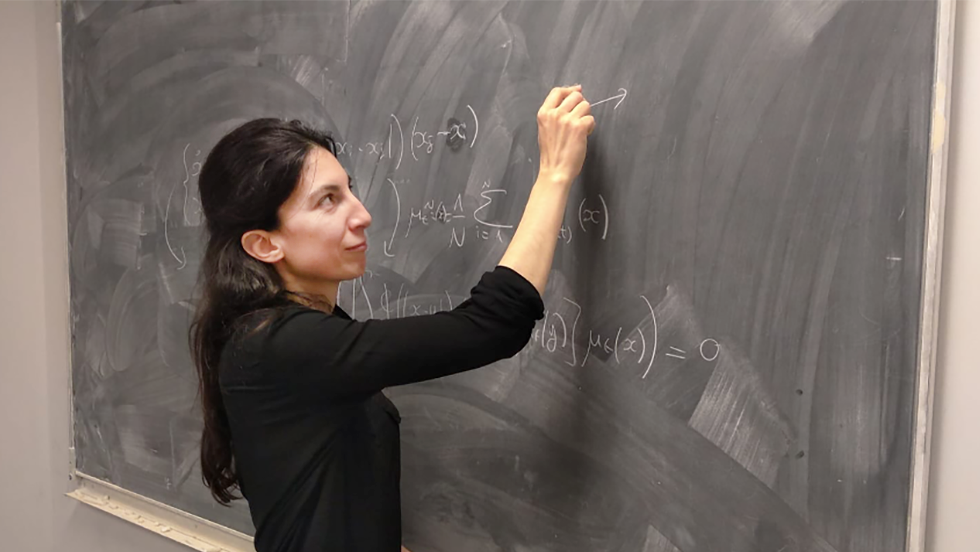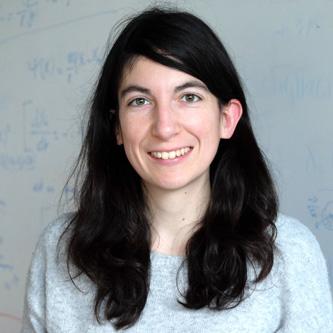Nastassia Pouradier Duteil, a passion for collective dynamics
Date:
Changed on 18/07/2024

In the words of Marie Curie, “There is nothing to fear in life, only to be understood.” This could well be the motto of Nastassia Pouradier Duteil, research fellow in mathematics applied to biology, given the role that curiosity and daring have played in her career to date. Although at secondary school her heart was torn between literature and mathematics, it was the latter she would eventually gravitate towards, believing it would be “easier to do maths for a living and read books in my spare time than the other way around”. This choice was driven primarily by the lure of a field “where everything seems to follow a logical progression.” After taking her classes préparatoires[1] in Lyon, Nastassia joined ENSTA Paris for three years, interspersed by a stint at the University of Moscow, quenching her thirst for travel while discovering new methods of teaching.
[1] In France the classes préparatoires are an intensive two-year post-baccalauréat course designed to prepare the best students for entry into the Grandes Écoles.
But Nastassia didn't see herself as an engineer and, driven more by a desire for understanding than for practical applications, she decided to expand her knowledge with a double Master’s at Pierre and Marie Curie University. This course had a large modelling component, introducing her to the possible links between mathematics and other scientific disciplines. It also gave her the inspiration to study for a PhD linked to control theory. “Control theory concerns the methods for modifying systems in order to reach a pre-determined state.
The classic example is parallel parking: what direction do you need to turn the wheel in? When? At what speed? I was drawn to this sort of mathematical problem, seeing it as a puzzle waiting to be solved through the beauty of mathematics.
Nastassia sees the beauty of mathematics in the way it provides simple solutions to apparently complex problems.
She would go on to defend her thesis Models for pattern formation in biological systems at the Center for Computational and Integrative Biology at Rutgers University in New Jersey where she was introduced to a new world: “I spent four years working alongside biologists in a discipline that was very different from my own. I was part of a team studying developmental biology, focusing on exploring every aspect of biological systems, in this case the fruit fly. The mathematical approach employed is different. We knew we would never be able to create a full model of such a complex system, and so we sought to extract the most important information by concentrating on the spinal cord, ignoring the flesh surrounding it.” Not only were the methods different, but the languages were too. Although this was never going to put off this polyglot, who speaks five different languages fluently, and who soon learned the language of the biologists.
Nastassia’s time in the States only whetted her appetite for research. When she returned to France and began a postdoc at Paris Dauphine University - PSL, she looked up labs which matched both her skillset and her passions in terms of their activities. She was drawn to Inria as a result of the university’s ties with the institute, joining the MAMBA project team in 2018.
“My research focuses on the links that can be established between different models for collective dynamics.” Whether it’s cells, birds or humans, when individual components of a group start interacting with their neighbours they are participating in a collective movement which can lead to a transition from a disorderly state to an orderly one.
“From a mathematical perspective it's fascinating seeing what determines whether or not a group will manage to structure itself when there is no centralised leader. Local interactions between components of a group can be enough to make the whole move as one. The two questions I’m most interested in relate to the collective behaviour of these groups of interacting particles, what leads to them becoming organised, and to the different levels they can be modelled at.
In addition to trying to find mathematical solutions to these theoretical questions, I am fortunate enough to be currently working with physicists studying shoals of fish.”
For anyone interested in group dynamics, Nastassia heartily recommends Fouloscopie, a YouTube channel which presents the subject in an informed but accessible way. “This is a very varied job; no two days are really alike”, says this young researcher, who is just at home working as part of a team as she is working alone.
As someone who loves maths it's great trying to find solutions on your own, but I also spend a lot of time in group brainstorming sessions.
For Nastassia, the rich and varied nature of these exchanges between researchers is a big part of why she enjoys her work so much.
Image

Verbatim
That plus being able to choose my own research topics and how involved in teaching I want to be. The level of freedom Inria gives us is priceless.
Auteur
Poste
Research Fellow
What qualities are needed for a career in research? “You need a good grounding in the theory, of course, but you also need scientific intuition, curiosity for other disciplines and a lot of creativity”, says Nastassia. “But the research field you end up going into is largely down to the people you happen to meet.” This may be true, but you also need to grasp opportunities and “get rid of any preconceptions that say you need to fit a certain profile in order to be a researcher.”
Anyone who has the passion can make it in research as there will come a time when their personal qualities come into use.
A joint initiative involving Inria, Sorbonne University and the CNRS, MAMBA (Modelling and Analysis for Medical and Biological Applications) is a project team made up of researchers in applied mathematics, computer science, statistical mechanics and medicine. With applications in both biology and medicine, their work on modelling multidimensional phenomena has led to the analysis of partial differential equations, to methods of simulation in statistical mechanics and to the development of robust digital methods. The topics they study include cell movement and the growth of cell populations (whether under physiological control or subject to the actions of medication) and the protein aggregation which occurs in so-called “amyloid” diseases such as Alzheimer’s disease, Parkinson’s disease, Creutzfeldt-Jakob disease or Huntington's disease). In collaboration with other research teams and experimentalists, one of MAMBA’s most notable achievements has been the development of methods for optimising cancer treatments.
But a transition is underway, and MAMBA will soon become “MUSCLEES”. Its main area of focus will still be mathematical biology, in addition to a new epidemiology component and greater emphasis on the multidimensional aspects of collective dynamics phenomena.